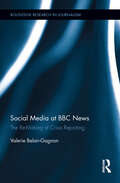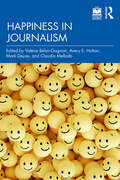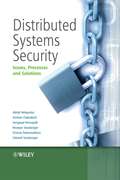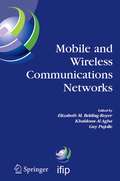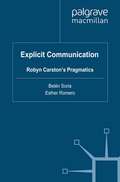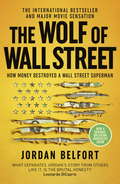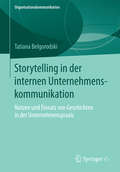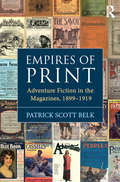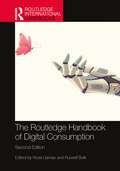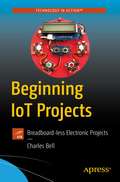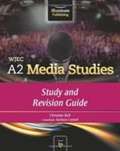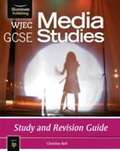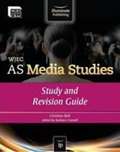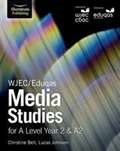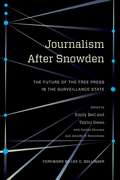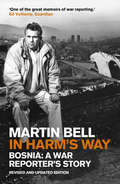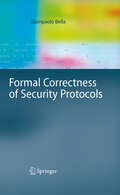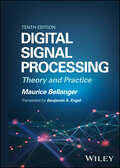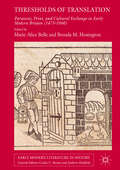- Table View
- List View
Social Media at BBC News: The Re-Making of Crisis Reporting (Routledge Research in Journalism)
by Valerie Belair-GagnonSince the emergence of social media in the journalistic landscape, the BBC has sought to produce reporting more connected to its audience while retaining its authority as a public broadcaster in crisis reporting. Using empirical analysis of crisis news production at the BBC, this book shows that the emergence of social media at the BBC and the need to manage this kind of material led to a new media logic in which tech-savvy journalists take on a new centrality in the newsroom. In this changed context, the politico-economic and socio-cultural logic have led to a more connected newsroom involving this new breed of journalists and BBC audience. This examination of news production events shows that in the midst of transformations in journalistic practices and norms, including newsgathering, sourcing, distribution and impartiality, the BBC has reasserted its authority as a public broadcaster. Click here for a short video about the book.
Social Media at BBC News: The Re-Making of Crisis Reporting (Routledge Research in Journalism)
by Valerie Belair-GagnonSince the emergence of social media in the journalistic landscape, the BBC has sought to produce reporting more connected to its audience while retaining its authority as a public broadcaster in crisis reporting. Using empirical analysis of crisis news production at the BBC, this book shows that the emergence of social media at the BBC and the need to manage this kind of material led to a new media logic in which tech-savvy journalists take on a new centrality in the newsroom. In this changed context, the politico-economic and socio-cultural logic have led to a more connected newsroom involving this new breed of journalists and BBC audience. This examination of news production events shows that in the midst of transformations in journalistic practices and norms, including newsgathering, sourcing, distribution and impartiality, the BBC has reasserted its authority as a public broadcaster. Click here for a short video about the book.
Happiness in Journalism
by Valérie Bélair-Gagnon Avery E. Holton Mark Deuze Claudia MelladoThis book examines how journalism can overcome harmful institutional issues such as work-related trauma and precarity, focusing specifically on questions of what happiness in journalism means, and how one can be successful and happy on the job. Acknowledging profound variations across people, genres of journalism, countries, types of news organizations, and methodologies, this book brings together an array of international perspectives from academia and practice. It suggests that there is much that can be done to improve journalists’ subjective well-being, despite there being no one-size-fits-all solution. It advocates for a shift in mindset as much in theoretical as in methodological approaches, moving away from a focus on platforms and adaptation to pay real attention to the human beings at the center of the industry. That shift in mindset and approach involves exploring what happiness is, how happiness manifests in journalism and media industries, and what future we can imagine that would be better for the profession. Happiness is conceptualized from both psychological and philosophical perspectives. Issues such as trauma, harassment, inequality, digital security, and mental health are considered alongside those such as precarity, recruitment, emotional literacy, intelligence, resilience, and self-efficacy. Authors point to norms, values and ethics in their regions and suggest best practices based on their experience. Constituting a first-of-its-kind study and guide, Happiness in Journalism is recommended reading for journalists, educators, and advanced students interested in topics relating to journalists’ mental health and emotion, media management, and workplace well-being. This book is accompanied by an online platform which supports videos, exercises, reports and links to useful further reading.
Happiness in Journalism
by Valérie Bélair-Gagnon Avery E. Holton Mark Deuze Claudia MelladoThis book examines how journalism can overcome harmful institutional issues such as work-related trauma and precarity, focusing specifically on questions of what happiness in journalism means, and how one can be successful and happy on the job. Acknowledging profound variations across people, genres of journalism, countries, types of news organizations, and methodologies, this book brings together an array of international perspectives from academia and practice. It suggests that there is much that can be done to improve journalists’ subjective well-being, despite there being no one-size-fits-all solution. It advocates for a shift in mindset as much in theoretical as in methodological approaches, moving away from a focus on platforms and adaptation to pay real attention to the human beings at the center of the industry. That shift in mindset and approach involves exploring what happiness is, how happiness manifests in journalism and media industries, and what future we can imagine that would be better for the profession. Happiness is conceptualized from both psychological and philosophical perspectives. Issues such as trauma, harassment, inequality, digital security, and mental health are considered alongside those such as precarity, recruitment, emotional literacy, intelligence, resilience, and self-efficacy. Authors point to norms, values and ethics in their regions and suggest best practices based on their experience. Constituting a first-of-its-kind study and guide, Happiness in Journalism is recommended reading for journalists, educators, and advanced students interested in topics relating to journalists’ mental health and emotion, media management, and workplace well-being. This book is accompanied by an online platform which supports videos, exercises, reports and links to useful further reading.
Distributed Systems Security: Issues, Processes and Solutions
by Abhijit Belapurkar Anirban Chakrabarti Harigopal Ponnapalli Niranjan Varadarajan Srinivas Padmanabhuni Srikanth SundarrajanHow to solve security issues and problems arising in distributed systems. Security is one of the leading concerns in developing dependable distributed systems of today, since the integration of different components in a distributed manner creates new security problems and issues. Service oriented architectures, the Web, grid computing and virtualization – form the backbone of today’s distributed systems. A lens to security issues in distributed systems is best provided via deeper exploration of security concerns and solutions in these technologies. Distributed Systems Security provides a holistic insight into current security issues, processes, and solutions, and maps out future directions in the context of today’s distributed systems. This insight is elucidated by modeling of modern day distributed systems using a four-tier logical model –host layer, infrastructure layer, application layer, and service layer (bottom to top). The authors provide an in-depth coverage of security threats and issues across these tiers. Additionally the authors describe the approaches required for efficient security engineering, alongside exploring how existing solutions can be leveraged or enhanced to proactively meet the dynamic needs of security for the next-generation distributed systems. The practical issues thereof are reinforced via practical case studies. Distributed Systems Security: Presents an overview of distributed systems security issues, including threats, trends, standards and solutions. Discusses threats and vulnerabilities in different layers namely the host, infrastructure, application, and service layer to provide a holistic and practical, contemporary view of enterprise architectures. Provides practical insights into developing current-day distributed systems security using realistic case studies. This book will be of invaluable interest to software engineers, developers, network professionals and technical/enterprise architects working in the field of distributed systems security. Managers and CIOs, researchers and advanced students will also find this book insightful.
Mobile and Wireless Communications Networks: IFIP TC6 / WG6.8 Conference on Mobile and Wireless Communication Networks (MWCN 2004) October 25-27, 2004 Paris, France (IFIP Advances in Information and Communication Technology #162)
by Elizabeth M. Belding-Royer Khaldoun Al Agha Guy PujolleMobile Ad hoc NETworks (MANETs) has attracted great research interest in recent years. A Mobile Ad Hoc Network is a self-organizing multi-hop wireless network where all hosts (often called nodes) participate in the routing and data forwarding process. The dependence on nodes to relay data packets for others makes mobile ad hoc networks extremely susceptible to various malicious and selfish behaviors. This point is largely overlooked during the early stage of MANET research. Many works simply assume nodes are inherently cooperative and benign. However, experiences from the wired world manifest that the reverse is usually true; and many works [3] [10] [9] [8] [12] [19] have pointed out that the impact of malicious and selfish users must be carefully investigated. The goal of this research is to address the cooperation problem and related security issues in wireless ad hoc networks. As a rule of thumb, it is more desirable to include security mechanisms in the design phase rather than continually patching the system for security breaches. As pointed out in [2] [1], there can be both selfish and malicious nodes in a mobile ad hoc network. Selfish nodes are most concerned about their energy consumption and intentionally drop packets to save power. The purpose of malicious nodes, on the other hand, is to attack the network using various intrusive techniques. In general, nodes in an ad hoc network can exhibit Byzantine behaviors.
Explicit Communication: Robyn Carston's Pragmatics (Palgrave Studies in Pragmatics, Language and Cognition)
by Belén Soria & Esther RomeroThis collection brings about a current interdisciplinary debate on explicit communication. With Robyn Carston's pragmatics at the core of the discussion, special attention is drawn to linguistic under-determinacy, the explicit/implicit divide and also to the construction or recruitment of concepts in on-line utterance comprehension.
The Wolf of Wall Street: More Incredible True Stories Of Fortunes, Schemes, Parties, And Prison (The\wolf Of Wall Street Ser. #1)
by Jordan BelfortNOW AN AWARD-WINNING MOTION PICTURE DIRECTED BY MARTIN SCORSESE, STARRING LEONARDO DICAPRIO, MATTHEW MCCONAUGHEY AND JONAH HILL.'What separates Jordan's story from others like it, is the brutal honesty.' - Leonardo DiCaprioBy day he made thousands of dollars a minute. By night he spent it as fast as he could, on drugs, sex, and international globe-trotting. From the binge that sunk a 170-foot motor yacht, crashed a Gulfstream jet, and ran up a $700,000 hotel tab, to the wife and kids who waited for him for at home, and the fast-talking, hard-partying young stockbrokers who called him king and did his bidding, here, in his own inimitable words, is the story of the ill-fated genius they called... THE WOLF OF WALL STREET In the 1990s Jordan Belfort, former kingpin of the notorious investment firm Stratton Oakmont, became one of the most infamous names in American finance: a brilliant, conniving stock-chopper who led his merry mob on a wild ride out of the canyons of Wall Street and into a massive office on Long Island. In this astounding and hilarious tell-all autobiography, Belfort narrates a story of greed, power, and excess no one could invent - the story of an ordinary guy who went from hustling Italian ices at sixteen to making hundreds of millions. Until it all came crashing down.
Storytelling in der internen Unternehmenskommunikation: Nutzen und Einsatz von Geschichten in der Unternehmenspraxis (Organisationskommunikation)
by Tatiana BelgorodskiTatiana Belgorodski untersucht erstmals das Erzählen von Geschichten, das Storytelling, mit Blick auf die interne Unternehmenskommunikation. Sie zeigt auf, wie Geschichten wirken und von welchen Einflussfaktoren ihr Nutzen für die interne (Change-)Kommunikation abhängt. Vor dem Hintergrund kognitions- und sozialpsychologischer Erkenntnisse werden Risiken und Chancen von Storytelling diskutiert, Interviews mit Unternehmensvertretern gewähren einen Einblick in die Praxis des Geschichtenerzählens in einem globalen Pharmaunternehmen. Die Autorin liefert eine umfassende Darstellung und Bewertung unterschiedlicher Storytelling-Beispiele und entwickelt ein Modell zum Einsatz und Nutzen des Storytellings für Kommunikationsmanagerinnen und -manager sowie Führungskräfte.
Empires of Print: Adventure Fiction in the Magazines, 1899-1919
by Patrick Scott BelkAt the turn of the twentieth century, the publishing industries in Britain and the United States underwent dramatic expansions and reorganization that brought about an increased traffic in books and periodicals around the world. Focusing on adventure fiction published from 1899 to 1919, Patrick Scott Belk looks at authors such as Joseph Conrad, H.G. Wells, Conan Doyle, and John Buchan to explore how writers of popular fiction engaged with foreign markets and readers through periodical publishing. Belk argues that popular fiction, particularly the adventure genre, developed in ways that directly correlate with authors’ experiences, and shows that popular genres of the late nineteenth and early twentieth centuries emerged as one way of marketing their literary works to expanding audiences of readers worldwide. Despite an over-determined print space altered by the rise of new kinds of consumers and transformations of accepted habits of reading, publishing, and writing, the changes in British and American publishing at the turn of the twentieth century inspired an exciting new period of literary invention and experimentation in the adventure genre, and the greater part of that invention and experimentation was happening in the magazines.
Empires of Print: Adventure Fiction in the Magazines, 1899-1919
by Patrick Scott BelkAt the turn of the twentieth century, the publishing industries in Britain and the United States underwent dramatic expansions and reorganization that brought about an increased traffic in books and periodicals around the world. Focusing on adventure fiction published from 1899 to 1919, Patrick Scott Belk looks at authors such as Joseph Conrad, H.G. Wells, Conan Doyle, and John Buchan to explore how writers of popular fiction engaged with foreign markets and readers through periodical publishing. Belk argues that popular fiction, particularly the adventure genre, developed in ways that directly correlate with authors’ experiences, and shows that popular genres of the late nineteenth and early twentieth centuries emerged as one way of marketing their literary works to expanding audiences of readers worldwide. Despite an over-determined print space altered by the rise of new kinds of consumers and transformations of accepted habits of reading, publishing, and writing, the changes in British and American publishing at the turn of the twentieth century inspired an exciting new period of literary invention and experimentation in the adventure genre, and the greater part of that invention and experimentation was happening in the magazines.
The Routledge Handbook of Digital Consumption (Routledge International Handbooks)
by Russell Belk Rosa LlamasSince the publication of the ground-breaking first edition, there has been an exponential growth in research and literature about the digital world and its enormous potential benefits and threats. Fully revised and updated, this new edition brings together an expertly curated and authoritative overview of the impact and emerging horizons of digital consumption. Divided into sections, it addresses key topics including digital entertainment, self-representation, communication, Big Data, digital spirituality, online surveillance, and algorithmic advertising. It explores developments such as consumer data collection techniques, peer-to-peer payment systems, augmented reality, and AI-enhanced consumer well-being, as well as digital transgression, secrecy, crypto-currencies, NFTs, and cultural concerns such as the spread of conspiracy theories and fake news. From digital influencers, digital nomads, and digital neo-tribalism to robots and cyborgs, it explores existences that blur boundaries between humans and machines, reality and the metaverse, and the emerging "technoculture" – a state of all-encompassing digital being. This unique volume is an essential resource for scholars, practitioners, and policy makers, and will continue to provide a new generation of readers with a deep understanding of the universe of digital consumption.
Beginning IoT Projects: Breadboard-less Electronic Projects
by Charles BellExperiment with building IoT projects without the demanding time or patience required to learn about electronics. This book thoroughly introduces readers of all ages to the world of IoT devices and electronics without getting bogged down by the overly technical aspects or being tied to a specific platform. You'll learn IoT, Arduino, Raspberry Pi from the ground up using the Qwiic and Grove components systems. The book begins with a brief overview of IoT followed by primers for the two most popular platforms; Arduino and Raspberry Pi. There is also a short tutorial on programming each host; Arduino C-like sketches and Python scripts respectfully. Thus, the book also helps you get started with your choice of platform. Next, you’ll learn the basics for the Qwiic and Grove component systems.The rest of the book presents a number of projects organized into easy-to-follow chapters that details the goal for the project, the components used, a walk-through of the code, and a challenge section that provides suggestions on how to improve or augment the project. Projects are presented for both the Arduino and Raspberry Pi where possible making each project as versatile as possible.What You'll LearnWrite Arduino sketchesCreate Python scripts for the Raspberry PiBuild IoT projects with Arduino and Raspberry PiUse the Qwiic and Grove component systemsJoin the electronics and IoT hobby world with almost no experienceHost projects data in the cloud using ThingSpeakWho This Book Is ForThose interested in building or experimenting with IoT solutions but have little or no experience working with electronics. This includes those with little or no programming experience. A secondary target would include readers interested in teaching the basics of working with Arduino and Raspberry Pi to others.
WJEC A2 Media Studies: Study and Revision Guide (PDF)
by Christine BellEndorsed by WJEC and written and edited by experienced senior examiners, this full-colour study guide precisely matches the WJEC A2 Media Studies course. It contains essential course notes, revision and coursework advice and support for every topic in the specification.
WJEC GCSE Media Studies: Study and Revision Guide (PDF)
by Christine BellEndorsed by WJEC and written by experienced senior examiner and teacher Christine Bell, this engaging, up-to-date course book and revision guide precisely matches WJEC GCSE Media Studies and will support your students' throughout their studies and help prepare them for their final exam.
WJEC A2 Media Studies: Study and Revision Guide (PDF)
by Christine Bell Barbara ConnellWritten by an experienced senior examiner and endorsed by WJEC, this study and revision guide is designed to accompany you through your course, as well as prepare you for the final exams.
WJEC AS Media Studies: Study and Revision Guide (PDF)
by Christine Bell Barbara ConnellEndorsed by WJEC and written and edited by experienced senior examiners, this full-colour study and revision guide precisely matches the WJEC AS Media Studies course. It contains essential course notes, revision and coursework advice and support for every topic in the specification.
WJEC/Eduqas Media Studies for A Level Year 2 & A2 (PDF)
by Christine Bell Lucas JohnsonThis book has been written specifically for the Eduqas A Level course and includes useful information to help you perform well in the examinations and the internally assessed unit. It is designed to be used in conjunction with the Year 1 book, where the aspects of the theoretical framework that are common to both the AS and the A Level specification were introduced. This book builds on that material, introducing the additional set products, topics and theories that are specific to the A Level.
Journalism After Snowden (PDF)
by Emily Bell Taylor Owen Smitha Khorana Jennifer R. HenrichsenEdward Snowden's release of classified NSA documents exposed the widespread government practice of mass surveillance in a democratic society. The publication of these documents, facilitated by three journalists, as well as efforts to criminalize the act of being a whistleblower or source, signaled a new era in the coverage of national security reporting. The contributors to Journalism After Snowden analyze the implications of the Snowden affair for journalism and the future role of the profession as a watchdog for the public good. Integrating discussions of media, law, surveillance, technology, and national security, the book offers a timely and much-needed assessment of the promises and perils for journalism in the digital age. Journalism After Snowden is essential reading for citizens, journalists, and academics in search of perspective on the need for and threats to investigative journalism in an age of heightened surveillance. The book features contributions from key players involved in the reporting of leaks of classified information by Edward Snowden, including Alan Rusbridger, former editor-in-chief of The Guardian; ex-New York Times executive editor Jill Abramson; legal scholar and journalist Glenn Greenwald; and Snowden himself. Other contributors include dean of Columbia Graduate School of Journalism Steve Coll, Internet and society scholar Clay Shirky, legal scholar Cass Sunstein, and journalist Julia Angwin. Topics discussed include protecting sources, digital security practices, the legal rights of journalists, access to classified data, interpreting journalistic privilege in the digital age, and understanding the impact of the Internet and telecommunications policy on journalism. The anthology's interdisciplinary nature provides a comprehensive overview and understanding of how society can protect the press and ensure the free flow of information.
In Harm's Way: Bosnia: A War Reporter's Story
by Martin BellMartin Bell's was BBC TV's principal correspondent during the war in Bosnia from 1992 to 1995. The original version of this passionate and personal account of the conflict was written while the war was still going on, some of it late at night in the Holiday Inn in Sarajevo. In Harm's Way is not only about the progress of the war; it is about its origins, how it began and how it could have been avoided; it is about the human costs of war in which all the peoples of Bosnia became the victims; it is about a massive failure by the United Nations, beginning with an inadequate peace-keeping mandate and ending with the Srebrenica massacre; and it is about the practices of war reporting itself. And it is about the journalists in the thick of it, the oddballs and the idealists, the wild adventurers and hardened professionals who were caught up in this war and tried to make some sense of it. In the introduction to this new edition, marking the twentieth anniversary of the outbreak of hostilities, Martin Bell reflects on the impact of what he calls the most consequential war of our time.
Formal Correctness of Security Protocols (Information Security and Cryptography)
by Giampaolo BellaThe author investigates proofs of correctness of realistic security protocols in a formal, intuitive setting. The protocols examined include Kerberos versions, smartcard protocols, non-repudiation protocols, and certified email protocols. The method of analysis turns out to be both powerful and flexible. This research advances significant extensions to the method of analysis, while the findings on the protocols analysed are novel and illuminating.
Digital Signal Processing: Theory and Practice
by Maurice BellangerDIGITAL SIGNAL PROCESSING Understand the future of signal processing with the latest edition of this groundbreaking text Signal processing is a key aspect of virtually all engineering fields. Digital techniques enormously expand the possible applications of signal processing, forming a part of not only conventional engineering projects but also data analysis and artificial intelligence. There are considerable challenges raised by these techniques, however, as the gulf between theory and practice can be wide; the successful integration of digital signal processing techniques requires engineers capable of bridging this gulf. For years, Digital Signal Processing has met this need with a comprehensive guide that consistently connects abstract theory with practical applications. Now fully updated to reflect the most recent developments in this crucial field, the tenth* edition of this seminal text promises to foster a broader understanding of signal processing among a new generation of engineers and researchers. Readers of the new edition of Digital Signal Processing will also find: Exercises at the end of each chapter to reinforce key conceptsA new chapter covering digital signal processing for neural networksHandy structure beginning with undergraduate-level material before moving to more advanced concepts in the second half Digital Signal Processing is a must-own for students, researchers, and industry professionals in any of the hundreds of fields and subfields that make use of signal processing algorithms. *This is the English language translation of the French original Traitement Numérique du Signal 10th edition by Maurice Bellanger © Dunod 2022 and is the 4th edition in English.
Digital Signal Processing: Theory and Practice
by Maurice BellangerDIGITAL SIGNAL PROCESSING Understand the future of signal processing with the latest edition of this groundbreaking text Signal processing is a key aspect of virtually all engineering fields. Digital techniques enormously expand the possible applications of signal processing, forming a part of not only conventional engineering projects but also data analysis and artificial intelligence. There are considerable challenges raised by these techniques, however, as the gulf between theory and practice can be wide; the successful integration of digital signal processing techniques requires engineers capable of bridging this gulf. For years, Digital Signal Processing has met this need with a comprehensive guide that consistently connects abstract theory with practical applications. Now fully updated to reflect the most recent developments in this crucial field, the tenth* edition of this seminal text promises to foster a broader understanding of signal processing among a new generation of engineers and researchers. Readers of the new edition of Digital Signal Processing will also find: Exercises at the end of each chapter to reinforce key conceptsA new chapter covering digital signal processing for neural networksHandy structure beginning with undergraduate-level material before moving to more advanced concepts in the second half Digital Signal Processing is a must-own for students, researchers, and industry professionals in any of the hundreds of fields and subfields that make use of signal processing algorithms. *This is the English language translation of the French original Traitement Numérique du Signal 10th edition by Maurice Bellanger © Dunod 2022 and is the 4th edition in English.
Thresholds of Translation: Paratexts, Print, and Cultural Exchange in Early Modern Britain (1473-1660) (Early Modern Literature in History)
by Marie-Alice Belle Brenda M. HosingtonThis volume revisits Genette’s definition of the printed book’s liminal devices, or paratexts, as ‘thresholds of interpretation’ by focussing specifically on translations produced in Britain in the early age of print (1473-1660). At a time when translation played a major role in shaping English and Scottish literary culture, paratexts afforded translators and their printers a privileged space in which to advertise their activities, display their social and ideological affiliations, influence literary tastes, and fashion Britain’s representations of the cultural ‘other’.Written by an international team of scholars of translation and material culture, the ten essays in the volume examine the various material shapes, textual forms, and cultural uses of paratexts as markers (and makers) of cultural exchange in early modern Britain. The collection will be of interest to scholars of early modern translation, print, and literary culture, and, more broadly, to those studying the material and cultural aspects of text production and circulation in early modern Europe.
Thresholds of Translation: Paratexts, Print, and Cultural Exchange in Early Modern Britain (1473-1660) (Early Modern Literature in History)
by Marie-Alice Belle Brenda M. HosingtonThis volume revisits Genette’s definition of the printed book’s liminal devices, or paratexts, as ‘thresholds of interpretation’ by focussing specifically on translations produced in Britain in the early age of print (1473-1660). At a time when translation played a major role in shaping English and Scottish literary culture, paratexts afforded translators and their printers a privileged space in which to advertise their activities, display their social and ideological affiliations, influence literary tastes, and fashion Britain’s representations of the cultural ‘other’.Written by an international team of scholars of translation and material culture, the ten essays in the volume examine the various material shapes, textual forms, and cultural uses of paratexts as markers (and makers) of cultural exchange in early modern Britain. The collection will be of interest to scholars of early modern translation, print, and literary culture, and, more broadly, to those studying the material and cultural aspects of text production and circulation in early modern Europe.
